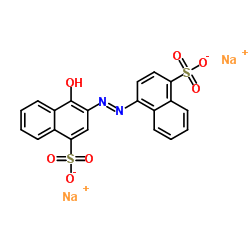Metabolic disposition of 14C-labelled carmoisine in the rat, mouse and guinea-pig.
J C Phillips, C Bex, D G Walters, I F Gaunt
文献索引:Food Chem. Toxicol. 25(12) , 927-35, (1987)
全文:HTML全文
摘要
The absorption, metabolism and excretion of 14C-labelled carmoisine has been studied in the rat, mouse and guinea-pig. Following administration of a single oral dose of either 0.5 or 50 mg/kg body weight, substantially all of the dose was recovered in the excreta within 72 hr, mainly in the faeces. Although the urinary excretion of radioactivity was similar in the rat and the mouse, the proportion of the radioactivity found in the urine of the guinea-pig was significantly greater than that of the other species at both dose levels. Pretreating male rats with unlabelled colouring in the diet (0.05%, w/w) for 28 days prior to dosing with 14C-labelled colouring had no effect on the route of excretion or the time taken to eliminate the majority of the labelled dose. Following a single oral dose of 14C-labelled colouring to previously untreated rats, mice and guinea-pigs or to rats pretreated as above, no marked accumulation of radioactivity in any tissue was found. Pregnant rats eliminated a single oral dose of 14C-labelled colouring at a similar rate to non-pregnant females, and the concentration of radioactivity in the foetuses was similar to that in the other tissues. Naphthionic acid was the major urinary metabolite in all three species. In the rat and mouse, most of the remaining radioactivity co-chromatographed with 2-amino-1-naphthol-4-sulphonic acid (2-ANS), but in the guinea-pig radioactivity also co-chromatographed with 1,2-naphthoquinone-4-sulphonate (1,2-NQS). Only a trace amount of unchanged carmoisine was detected in the urine of the species examined. Naphthionic acid was also found in the faeces of all three species, but neither carmoisine, 2-ANS or 1,2-NQS was detected. At least five other radioactive metabolites were found in the faecal extracts of all three species, including a substantial amount of a compound with chromatographic properties similar to those of a trace metabolite in the urine. Two of the faecal metabolites were hydrolysed by beta-glucuronidase and sulphatase treatment. In studies on the absorption of carmoisine at concentrations of 50, 500 or 5000 ppm from isolated intestinal loops, no significant absorption was detected in the rat, mouse or guinea-pig.
相关化合物
| 结构式 | 名称/CAS号 | 分子式 | 全部文献 |
|---|---|---|---|
 |
铬变素FB
CAS:3567-69-9 |
C20H12N2Na2O7S2 |
|
Determination of vanadium in groundwater samples with an imp...
2014-01-01 [Environ. Technol. 35(9-12) , 1165-74, (2014)] |
|
Toxic effects of some synthetic food colorants and/or flavor...
2013-03-01 [Toxicol. Ind. Health 29(2) , 224-32, (2013)] |
|
Pattern of intake of food additives associated with hyperact...
2010-04-01 [Food Addit. Contam. Part A. Chem. Anal. Control. Expo. Risk Assess. 27(4) , 447-56, (2010)] |
|
Estimates of dietary exposure of children to artificial food...
2006-03-01 [Food Addit. Contam. 23(3) , 245-51, (2006)] |
|
Microbiological research on soft drinks: discolouring of nat...
1992-01-01 [Zentralbl. Mikrobiol. 147(1-2) , 51-60, (1992)] |